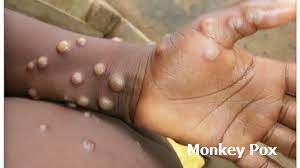
Vaccsbook

Infectious Diseases . . . and How to Avoid Them
Monkeypox

This information is for entertainment purposes only. It has not been verified by a third party. Last updated: a while ago.
Disease
MonkeyPox is a viral disease spread from animals to humans, and then from humans to other humans.
Type of Infection
The Monkeypox virus was initially isolated from research monkeys in 1958.
It is a
DNA virus of the Poxviridae family, which also includes the Small Pox virus.
Poxviridae virions are among the largest, about 250 nanometers in length.
The DNA is double stranded and configured into a dumbell shape,
and up to 6 times more complcated than the SARS-Cov2 (COVID-19) virus.
There are two "clades"; (two strains that evolved along two distinct genetic lines) commonly known as
the Congo Basin (Central African) clade and the West African clade,
the former being more transmissible and causing more severe disease and fatalities.
However, the WHO
"to avoid offending any cultural, social, national,
regional, professional, or ethnic groups and minimize any negative impact on trade, travel,
tourism or animal welfare",
has deemed that the clades be renamed as Clade I and Clade II, with future variants
denoted by a lowercase letter, e.g. Clade Ia, Clade Ib etc.
Geography
Monkeypox is common in central and west Africa, but few cases have been seen elsewhere.
Consequently there is comparitively little information on its characteristics.
In Spring 2022, Monkeypox of the West African (less severe strain) was diagnosed in Western Europe, North America, and Australia;
some cases have been linked to African travel, other cases have no identified source.
There is concern that Monkeypox could be transmitted back to animals, and thus become endemic in these regions.
Prevention
Prevention is by usual public health measures; self-isolation and aviodance of infected people, avoidance of their clothing/utensils, strict hand hygiene, disposable masks and dispoable gloves.
Vaccination
There is no specific Monkeypox vaccine, although previous vaccination against Smallpox may give some protection.
Smallpox vaccination has not been routinely given since the disease was deemed eradicated 40+ years ago, and is not available publicly.
However, developed countries maintain supplies of Smallpox vaccine (Modified Vaccina virus Ankara, MVA-BN)
for use in emergency/bio-terrorism situations.
It requires two doses four weeks apart and has various tradenames such as ACAM2000, Imvanex, Imvamune, and Jynneos.
An mRNA vaccine specific for Monkeypox maybe in the early stages of development.
Close contacts of confirmed Monkeypox cases in EU and North America are being offered MVA-BN.
Acquisition & Transmission
Monkeypox infects monkeys, apes, rats, mice, squirrels, prairie dogs, and rabbits. Humans can become infected by physical contact with an infected animal, or eating undercooked meat from these. Subsequent human to human transmission can occur.
Contagion
Humans are contagious while symptomatic (typically 2 to 4 weeks from symptom onset).
The virus is known to spread through close personal contact, particularly contact with the fluid of blisters,
other bodily fluids, and contact with contaminated cothing/bedding and eating utensils.
Trans-placental transmission is also believed to occur.
Due to the recent (2022) occurence of hundreds of cases in Western Europe, North America, and Australia,
there is a surge in research to confirm spread by respiratory droplets, aerosolized virions, and virion presence
in semen and vaginal fluids.
This atypical spread to non-endemic countries is raising concern that the virus may have mutated away from that previously identified in Africa.
Signs and Symptoms
Initial signs and symptoms are a high temperature, severe headache, muscle aches, fatigue, swollen lymph nodes (glands), and chracteristic skin lesions appearing as fluid filled blisters. The blisters are usually widespread on the face, trunk, arms and legs.
Timeline
Incubation (from exposure to initial symptoms) is usually 7 to 14 days, but may be up to 1 month. Skin lesions typically appear 2-4 days after initial symptoms; symptoms then last a further 2 to 4 weeks.
Diagnosis
Monkeypox is diagnosed on the basis of characteristic signs and symptoms, and exposure to a known case.
Antibodies to Monkeypox are similar to those for Smallpox and Cowpox, so not completely diagnostic.
PCR kits are available and considered the best method of testing.
Body Systems Affected
The initial disease affects the skin, most concentrated on the plams and soles. Significant swelling of lymph nodes (glands) in the neck, armpits and groins occurs (unlike Smallpox). Severe cases can cause pnemonia, encephalitis (brain inflammation), and retina (eye) damage.
Treatment
Where possible, the blisters should be allowed to dry and resolve,
while treating any skin infection with aseptic dressings and antibacterials.
Severe case may need intravenous "Vaccinia Immune Globulin" comprising antibodies from donors previously vaccinated againsty SmallPox.
The anti-viral drug Tecovirimat (brand name TPOXX), initially developed for use against Smallpox, is now being used in non-endemic countries.
It is available in both oral and intravenous forms.
Complications
Severe cases can involve pneumonia, encephalitis, skin infections, and eye infections leading to loss of vision. Fatalities can occur due to pneumonia or septic shock due to rapidly spreading bacterial skin infections.
Fatalities
In endemic areas (i.e. areas where the disease is continually present) the death rate is estimated at 1% to 10%, but statistics in such areas are likely incomplete/inaccurate.
Epidemics & Pandemics
Since the first human case in 1970, there have been frequent outbreaks in Africa;
there is little documentation that any outbreak has been declared an epidemic.
In 2003, an outbreak occurred in the USA mid-west with 70 cases but no fatalities; the source was traced to rats imported from Africa.
However, the size of African outbreaks began to increase in the 2010s, possibly due to increasing years since SmallPox vaccination was discontinued.
In the last two weeks of May 2022, the number of cases reported in outside Africa rose rapidly;
over 600 cases in 30 non-endemic countries, with cases doubling weekly.